Pedro Duque: General Manager of Deimos Imaging and astronaut on reserve leave of the ESA (European Space Agency)TECHNICAL
Pedro Duque was born in Madrid on 14th March 1963. He graduated from the Polytechnic University of Madrid (Higher College of Aeronautical Engineering) with a Degree in Aeronautical Engineering in 1986. It was at this point that his career became meteoric. He started working as an intern in GMV (Flight Mechanics Group) and was appointed to the European Centre of Space Operations (ESOC) of the European Space Agency (ESA) in Darmstadt (Germany) shortly afterwards. He worked in the Precise Orbit Determination Group, participating in the flight control team for two ESA satellites, until 1992.
In May 1992, he was selected for the ESA’s Astronaut Corps. He underwent Basic Training at the European Astronaut Centre (EAC) in Cologne (Germany) and then attended another course at the Russian TSPK astronaut-training centre, in Star City, as part of a project designed to establish open cooperation between the ESA and the MIR Russian space station. Upon his return from Russia in 1993, he began to prepare for the joint ESA-Russia Space Mission called “EUROMIR 94”, receiving the official qualification of Scientist- Astronaut for the Soyuz and MIR spacecraft. He was selected as a member of the reserve crew and ground communications coordinator liaising with Russia for the EUROMIR 94 space mission in May 1994. In 1995, he trained in Star City to support the joint ESA-Russia “EUROMIR 95” space mission. He was appointed Reserve Scientist-Astronaut for the Life and Microgravity Spacelab mission that same year.
In 1996, Pedro Duque trained as a NASA Flight Engineer and began working at the Johnson Space Centre. In early 1998, he was appointed member of the crew of the STS-95 Space Shuttle Flight, in a joint mission for NASA, the ESA and the Japanese Agency NASDA. On 29th October 1998, Pedro Duque went into space for the first time, as a Flight Engineer of the “Discovery” Space Shuttle. Between 1999 and 2003, he worked on the European components of the International Space Station, in the European Space Research and Technology Centre (ESTEC) situated in Noordwijk (Holland). He was among the first set of European Astronauts to qualify with advanced training in 2001 and he was Flight Engineer for the Cervantes Space Mission between 18th and 28th October 2003.
Pedro Duque has participated in four spaceflights, all related to scientific research, which makes him an expert in adapted space experiments. After his last spaceflight, the ESA appointed him Operations Director of the Spanish User Support Operations Centre for the International Space Station, which is part of the “Ignacio da Riva” Microgravity Institute of the Polytechnic University of Madrid.
Pedro Duque has been on leave of absence from the ESA since October 2006, although he remains on standby should he be needed. Among other special honours, he has received the Russian Federation’s “Order of Friendship” from President Yeltsin (March 1995) and the Great Cross to Aeronautical Merit from HM the King of Spain (1999). He has been a Member of the Royal Engineering Academy of Spain since April 1999. Along with another three astronauts, he received the Prince of Asturias Award for International Cooperation in October 2009.
"There is a great accumulation of risks in the space" Pedro Duque, the first Spanish astronaut to visit space and employee of the European Space Agency (ESA), reveals himself to be a person of simple pleasures, who is passionate about space and adept at overcoming great challenges. Here, we join him to review some of the milestones and myths of the space race and learn more about the international aeronautics and space industry, in which Spain has been playing a role for more than 20 years, thanks to its involvement with the ESA. As General Manager of the first completely private European company to put its own satellite into orbit and sell its Earth imaging services, he provides us with some interesting facts.
How did you first develop an interest in space
and when did you first feel the desire to become
an astronaut?
I’ve always had an interest in aeronautics, even
from my childhood. The reason is simple: my
father was an air traffic controller and we have
always shared an interest in aeroplanes. He
used to take us to the control tower, in the
airport. I even tried the flight simulator once,
one of those that pilots use to train. Undoubtedly,
this spurred my interest in aeronautics and
encouraged me to become an aeronautical engineer
and it was a small step from there to
developing an interest in space.
How did you first get the chance to become an
astronaut?
When I was finishing my degree, the government
approved a new Law on Science, under
which Spain would begin to take part in international
R&D (Research and Development)
projects and become more involved in international
programmes and agencies. One of these
organisations was the European Space Agency
(ESA) and one of the selected laboratories was
the one at the university where I was working
as a research fellow. We formed a group that
began formalising contracts with the ESA. The
opportunity came about because the Spanish
Government began to allocate more resources
to international projects from that moment
onwards, which would come back in the form
of contracts with the industry; some of the
other aeronautical engineers and I became
converts to aerospace engineering.
The first time you look through the window and see Earth, with its dark horizon and the Sun, is indescribable.
How were you selected from the different candidates
wanting to work at the European Space
Agency?
Let me tell you a story: when the results of the selection process were about to be published I
began to receive calls from all the radio stations
and TV channels, even before anyone contacted
me officially. The authorities in charge of the
selection process inform the government first
and afterwards the candidates. But there are
so many people involved in the process that any
news always gets leaked.
When did you first travel to space?
I first travelled to space on 29th October 1998.
I spent a year in Russia before that. I lived in
Star City, a small village with only 5,000 residents
and the location of the space training
and research facility, with its technicians and
engineers. The place has restaurants, schools,
cinemas, everything you might need to make
life pleasant for the people living there, because Star City was the product of Soviet planning,
which, at least where questions of space were
concerned, was autarchic.
Where else can ESA astronauts receive training?
The International Space Station is run by the
USA, Russia, Japan, Canada and the ESA, representing
many European countries. All these
countries have centres for training astronauts.
Right now, anyone who is going to spend any
time in the Space Station has to learn how it
works, and each centre specialises in one field,
which means that the trainee has to pass through
all of them. This means that they spend their
lives travelling.
Moving on to sensations, how does it feel to
see the Earth from space?
It is incredibly overwhelming, even though we
all receive training and are fully prepared for it.
Obviously, we have seen the photographs and
videos before we embark on a mission and we
receive training so that we are prepared for the
fast movements onboard the spacecraft. And if
there is anything to see below, the onboard
computer will tell you exactly where it is. Even
so, it is awe-inspiring. The first time you look
through the window and see Earth, with its dark
horizon and the Sun, an indelible memory is left.
What do you think of during those moments?
I do not know what to say, to be honest. All the
preparation and training teaches you to detach
yourself from the situation, to feel as little as
possible. I usually compare it to people who
climb mountains: they make a titanic effort to reach the peak, they look around, do whatever
it is they have to do there and come back down
and they do not think about it too much.
What should humanity’s immediate objectives
in space be?
I don’t see any specific objectives as such. But
it is all justified by the desire to explore, to
transcend the barriers of knowledge, by the step
forward that it represents for the human race,
for a country or for a society. This is a special
year because on 21st of July, we celebrated the
40th anniversary of man’s landing on the Moon.
At the time of the landing, there was a lot of
momentum behind the exploration of space, for
various reasons. One of them was that the US
wanted to be the first country to reach the Moon
and so there were numerous experiments on
weightlessness or zero gravity, involving many
different fields: physics, medicine, biology. There
was a whole series of experiments on the effects
of gravity. Because of these experiments, we began to research how cells relate to each other,
how life comes about, how we have evolved, how
materials behave. And there are many other
benefits that we take for granted now that would
not have been possible without space exploration
and research. As an example, we now have
satellites that transmit information practically
in real time; in other words, any news or any
developments are disseminated instantaneously
and this gives us an overall view of the world,
which has revolutionised the way in which we
understand the world and relate to one another.
We are no longer as isolated as we were. We
know that any event happening at any time,
anywhere in the world, can be reported on the
news in a matter of hours and we take this for
granted. The same applies to travelling using
GPS. We can act as though navigation is no
longer a problem. Why? Because we have managed
to create a system, a network of 48 satellites
in space. And we have also managed to
carry large and heavy cargo into space.
What is it like living with other astronauts in
space?
It is difficult, because you are in a very small
space and you have to share everything. It is
like crossing the Atlantic in a small sailing
boat. You would be short of space. There are
specific needs that have to be met when you
are living so close together and everyone has
to adapt to each other.
What do you think about tourism in space for
those that can afford the trip?
It is like everything else in life. Initially, only
people with a lot of money could afford to buy
a ticket to board a plane. As the industry grew
and received finance, it began to design more
efficient and comfortable planes, finally creating
a form of mass transportation. The same has
happened with many of humanity’s inventions.
The first cars were only available to the wealthier
upper classes. Thanks to the large amounts of
money paid for these cars, the factories were able to invest money in R&D, allowing them to
make more efficient vehicles that were then
accessible to more people.
Which countries are currently the dominant
players in space?
The US is still the superpower in space, at least
for the moment, followed by Russia, which specialises
in the construction of rockets that can
carry very heavy cargo into space. Progress in
Europe is not as efficient and very difficult, but
that is to be expected, as ten times less public
money is allocated to space programmes in Europe.
We do stand out in the areas in which we
specialise and we are on a par with the US or
Russia in that sense. For instance, the European
cargo rocket easily competes with the American
or Russian, although the Russian cargo rocket
is probably more cost-efficient.
I was at the last International Astronautical
Congress and learnt that India is only waiting
for the Authorities to sign the necessary documents
before it implements its own astronaut
training programme and anything else that is
needed. The only problem in the US is that space
exploration budgets began to decline in real
economic terms months before Armstrong even
stepped on the Moon and they have been falling
steadily ever since.
Perhaps that is because there are more pressing
problems on Earth, such as fighting hunger,
disease or providing education, for example.
Of course, I agree, but the only way to solve
many of these problems is through R&D. As an
example, I would cite the extensive research
into climate change and the fact that we now
know a lot more about it thanks to the observation
of the planet from space. It is also true that
the current lack of funding in the western sphere
has meant that other great powers, such as
China, have been able to catch up and meet the
challenges of space exploration with very little
funding, but this is also thanks to the fact that
they have had access to the knowledge and skills
that other countries developed beforehand
through experimentation and research.
The USA and Russia have been investing in space
exploration and research for the last 50 years,
under the belief that it ultimately boosts the
self-confidence of a nation. It constitutes an
enormous stimulus to education and training.
People perceive that their country is at the cutting
edge of something as thought provoking and awe-inspiring as outer space. The US is a world
power because it dominates space. China and
India have taken note of this.
Space tourism is no different to what humanity has experienced with other inventions.
What would you say is the key to the USA’s
dominance of the space race?
The USA is sufficiently open to public debates as
a country. Where space exploration is concerned,
we have yet to see what President Obama’s approach
will be. Nevertheless, the US is the most
technologically advanced country in the world and
should be able to put a man on Mars in coming
years. It is also a question of budgets: NASA received
only 0.5% of the US’s Federal Budget this year,
which is not very much, but it is still 10 times more
than the sum invested in Europe. If there is something
that needs to be done industrially, it can be
done in the US, which is currently the benchmark
country. Until 20th January, the US refused to
partner or collaborate with any other nation for
the project of establishing a permanent base on
the Moon by 2020. Now it is all up in the air.
Clearly, the US’s policy with regard to space is to
consolidate its dominant position, although it is
open to cooperation where certain matters are
concerned.
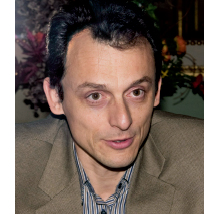

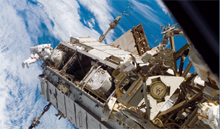
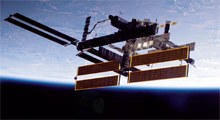
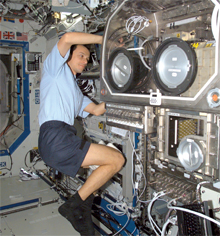
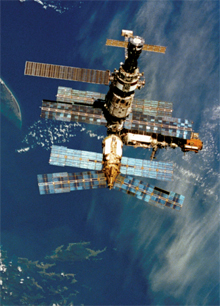
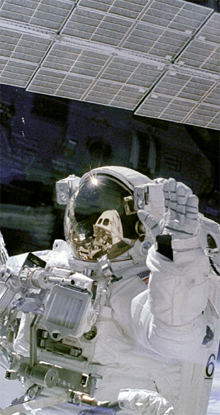
A private satellite that makes history
As an astronaut turned businessman, how does
the corporate world compare with your experiences
of physical risk in space?
There are similarities. Though I must emphasize
that the company is not mine, I am only the Managing
Director. In space programmes, the astronaut
is up there, at the top of the system, which
means that everyone looks to you for advice.
However, the experience of being an astronaut,
of living in space, gives you a certain approach,
where you are more prepared to listen to others
than to establish strict chains of command.
Tell us about Deimos Imaging and where the
capital came from.
Deimos Imaging is the first fully private European
company to operate its own Earth Observation
space satellite. The share capital came from a
Spanish corporate group, called Elecnor. The
group founded a company 7 years ago, called
Deimos Space, which employs young engineers
from Spain and carries out work for the European
Space Agency. Deimos Imaging is an offshoot of
that initial company.
Given that the Deimos project creates added value
through R&D&I (Research, Development and Innovation),
how far would you say Spain has come?
How strong is the Spanish aerospace industry?
Spain first began to contribute to the European
Space Agency about 23 years ago. Since then, the
country has built and consolidated an aerospace
industry. Initially, our share in the project was
only 5%. It is currently 7% and will reach 10% in
the future. It would be almost impossible to have
a 100% share. Spain fits in well in certain niches.
We have between 2,000 and 3,000 employees who
are 100% dedicated to space work. There is a lot
of uncertainty at the moment, because it is difficult
to predict how things will develop or determine
whether it is best to cut spending in the light of
the financial crisis or to boost investment in R&D&I
on the supposition that it will help us come out of
the crisis sooner. Nevertheless, the aerospace
industry could find itself in a better position.
Can the European Galileo project help Spain’s
aerospace industry?
It is helping. Spain has a share of 10% or more
in the project. In fact, our company manufactures
the most critical computers within the whole
Galileo system. They are built in Tres Cantos, on
the outskirts of Madrid. Some extremely difficult
and critical tasks are allocated to Spain, which
is proof of our enormous potential.
Obviously, Deimos Imaging has carried out its
viability studies, knowing that it will be competing with other companies that provide similar
services. What would you say constitutes Deimos
Imaging’s competitive advantage?
Obviously, there are already Earth Observation
Satellites in space, but these are used for experiments,
as prototypes. What we have done is
design a satellite that can take images that are
much larger, but more importantly, that can
take them much more frequently. This creates
more opportunities as we can monitor Earth
more intensively. The satellite was launched in
mid-July 2009, using a Russian rocket called
the Dnieper, which is an intercontinental ballistic
missile adapted for these purposes, which has
been used and tested extensively.
Everyone is waiting to see the quality of our
images before signing any contracts. Our satellite
Deimos-1 rotates around Earth, from pole
to pole, at a height of 600 kilometres. The satellite
has a guaranteed life of 5 years, but satellites
from the same series have lasted longer, between
8 and 10 years. It all depends on how we
treat it. I must clarify that we purchased this
satellite as a capital good and that the added
value comes from the applications that we have
developed and the quality of these applications.
The monitoring base is situated in Boecillo,
Valladolid. We have invested approximately 30
million euros in the whole project.
What is the expected ROI?
If it is positive, it will be a great achievement.
What can you tell us about the insurance schemes
that are developed for these space programmes?
There is a great accumulation of risks in space,
obviously, because you are pushing technology to its
maximum limits. The margins of error in our designs
are very narrow, less than 5%. Evidently, we need
insurance. It is essential whenever you embark on
a space project and it is great that we can find insurers
that specialise in insuring space projects in Spain.
Deimos Imaging is the first private European company to operate its own Earth Observation Satellite.
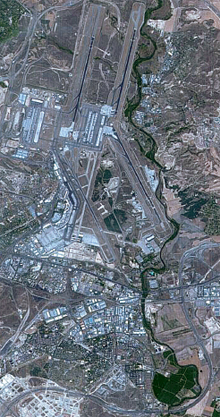

a. Sputnik Satellite
b. Front Page: Yuri Gagarin, fist human
in space
c. Buzz Aldrin's footprint on the moon
d. Skylab Space Station
NASA/courtesy of nasaimages.org
Milestones in the Conquest of Space
- 4th October 1957. The USSR launches the first Earth-orbiting artificial satellite, called Sputnik I. It remains in orbit for three months, circling the earth every 96 minutes. Sputnik II would later take the dog Laika into space.
- April 1961. The Russian cosmonaut Yuri A. Gagarin is the first man to see Earth from space, on board the Vostok 1 spaceship.
- March 1965. The Russian cosmonaut Alexey A. Leonov is the first human to conduct a space walk.
- 1966. The Russian spacecraft Luna 10 lands on the Moon.
- 20th July 1969. Man walks on the moon. The feat is achieved by American Astronauts Neil A. Armstrong, E.E. Aldrin and M. Collins, as part of NASA’S Apollo 11 mission.
- 1971. The first manned orbital space station, the Russian Salyut 1, is launched. The crew spends three weeks in space but perishes on re-entry to Earth.
- May 1973. The US puts the first space laboratory, called the Skylab, into orbit; three different crews will visit the station.
- 1986. The first module of the Russian MIR (Peace) space station is put into orbit; the station will remain operative for 15 years.
- 1995. The Russian cosmonaut Valeri Polyakov breaks the record for the longest period spent in space by man. He spends 438 days in the MIR space station, between January 1994 and March 1995.
- November 1998. The first module of the International Space Station, in which 17 countries are involved, is put into orbit.
- 9 space missions take place between 2000 and 2004. The new century sees the space race accelerate, with numerous space missions. At the same time, new projects with ambitious objectives are developed, such as the installation of a permanent base on the Moon or a manned space mission to Mars.
For more information, please visit: http://www.conquistadelespacio.net

